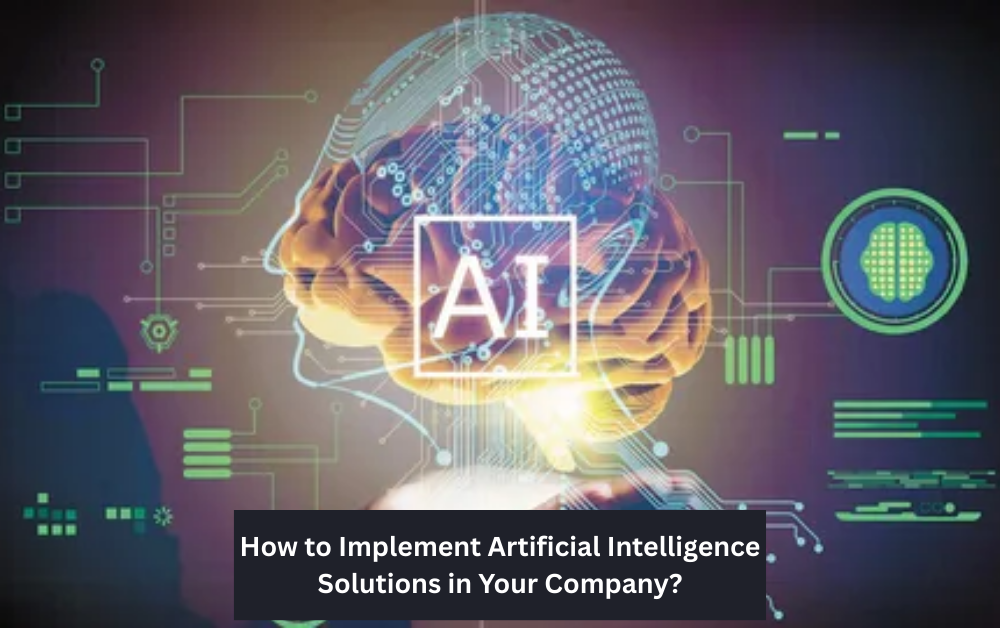Artificial Intelligence (AI) has proven to be a transformative force in the business world, offering companies the ability to streamline operations, improve customer experiences, and make data-driven decisions. While the potential of AI is undeniable, many businesses struggle to understand how to implement these solutions effectively. Implementing AI requires careful planning, the right resources, and a well-defined strategy to ensure that the technology serves your company’s goals.
In this article, we will walk you through the steps involved in implementing AI solutions in your company, from assessing your needs to selecting the right AI tools and integrating them into your business processes. Whether you’re in manufacturing, retail, healthcare, or any other industry, the following guide will provide you with a roadmap for a successful AI implementation.
Assessing Your Business Needs for AI
Before diving into the world of Artificial Intelligence, it’s essential to first assess the specific needs of your business. AI can enhance various aspects of business operations, but not all AI solutions will be relevant to every company. Understanding where AI can make the most impact will help you prioritize your investments and ensure a successful implementation.
Identify Business Challenges
Start by identifying the areas in your business where AI could solve critical challenges. This might include automating routine tasks, enhancing customer service, or gaining deeper insights from your data. For example, if your company deals with large volumes of data, AI-powered analytics tools can help you extract meaningful insights. Alternatively, if you face inefficiencies in your supply chain, machine learning (ML) algorithms could help with predictive maintenance or demand forecasting.
Note:- Artificial Intelligence Solutions have been seamlessly integrated by Nex Information Technology, empowering businesses to automate processes and improve decision-making. Companies benefited from more efficient operations and better insights. If you’re ready to revolutionize your business, contact Nex Information Technology today to explore AI-powered solutions.
Set Clear Objectives
Once you’ve identified potential challenges that AI could address, it’s crucial to set clear, measurable objectives for your AI implementation. These goals should align with your company’s broader business objectives. For instance, your objective could be to increase operational efficiency by a certain percentage or to enhance customer engagement by utilizing AI chatbots. Setting realistic goals will give you a clear direction and enable you to evaluate the success of your AI implementation.
Choosing the Right AI Solution
With a clear understanding of your business needs, the next step is selecting the right AI solution. There are a variety of AI tools available in the market, each serving different functions. The key is to select solutions that fit your company’s specific goals and challenges.
Explore Different Types of AI Solutions
There are several types of AI solutions available, including:
- Machine Learning (ML): This involves training algorithms to learn from data and make predictions or decisions based on patterns.
- Natural Language Processing (NLP): NLP helps computers understand and interact with human language, which is widely used in chatbots and virtual assistants.
- Robotic Process Automation (RPA): RPA automates repetitive tasks like data entry, invoicing, and customer service inquiries.
- Computer Vision: AI systems can analyze visual data, such as images and videos, and use them for purposes like object recognition and facial recognition.
- Predictive Analytics: These AI tools use historical data to forecast future trends, helping businesses make better-informed decisions.
Evaluate Vendor Solutions
When choosing an AI solution, consider whether to build an in-house system or use a vendor solution. Many AI vendors offer pre-built solutions that can be integrated into your existing infrastructure. If you decide to go with a vendor, make sure to evaluate several options based on criteria such as scalability, support, ease of use, and integration capabilities. It’s also vital to assess the vendor’s track record and expertise in your industry.
Building the Right AI Team
Successful AI implementation requires the right talent. Depending on the scope of your project, you will need a combination of technical and business professionals to manage the implementation process.
Key Roles in an AI Implementation Team
- Data Scientists: These experts analyze and interpret large datasets, building machine learning models that can be applied to your business needs.
- AI Engineers: AI engineers are responsible for developing and deploying AI systems, ensuring that they function effectively within your company’s infrastructure.
- Business Analysts: These professionals help bridge the gap between AI technology and business needs. They are responsible for defining requirements, assessing the performance of AI systems, and ensuring that AI implementation aligns with business objectives.
- IT Specialists: AI solutions require robust IT infrastructure to support data processing and system integration. IT specialists ensure that your infrastructure can handle the demands of AI tools.
In some cases, you might also need external consultants or AI experts to guide you through the process. Make sure that your team has the necessary skill sets to manage the technical complexities of AI while understanding the business context in which the technology will be applied.
Preparing Your Data for AI
AI systems rely heavily on data, and the quality of the data you use will directly impact the effectiveness of your AI solutions. Ensuring that your data is clean, structured, and relevant is a critical step in the AI implementation process.
Collect and Organize Data
Gather relevant data from all business functions that AI will impact. This could include customer data, financial records, inventory logs, or sales performance. Your data should be structured and easily accessible, ideally in a format that can be fed into machine learning models. If your data is siloed across different departments or systems, you will need to integrate it to provide a comprehensive view.
Clean and Validate Data
Data quality is a major factor in the success of AI solutions. AI systems can only produce reliable results if they are trained on high-quality data. This means eliminating any inaccuracies, inconsistencies, or duplicates in the data. Additionally, it’s important to validate the data to ensure that it reflects real-world scenarios.
Ensure Data Privacy and Security
When collecting and processing data, it’s crucial to follow best practices for data privacy and security. With regulations such as GDPR and CCPA, you must ensure that your data handling practices comply with legal requirements. AI systems that deal with sensitive data, such as customer information or health records, must have robust security measures in place to prevent breaches.
Integrating AI Solutions into Your Business Processes
AI solutions are most effective when they are fully integrated into your business processes. This allows you to automate tasks, gain insights, and improve decision-making across your organization.
Start with Pilot Projects
Rather than rolling out AI across your entire business at once, it’s a good idea to start with small, manageable pilot projects. This approach allows you to test the effectiveness of the AI solution, measure performance, and make adjustments before scaling up. For example, you could implement a chatbot for customer support in one department before expanding it company-wide.
Align AI with Business Workflow
AI solutions should be integrated seamlessly into your existing workflows. The technology should support and enhance human tasks, rather than replacing them entirely. For example, in sales, AI-powered tools can help identify promising leads or recommend actions based on customer behavior, but sales representatives will still play a critical role in closing deals.
Monitor and Evaluate AI Performance
Once the AI solution is implemented, continuous monitoring and evaluation are essential. Track key performance indicators (KPIs) to assess whether the AI system is meeting the objectives you set in the planning stage. AI tools should be optimized and fine-tuned over time, so make sure you have the resources to monitor and adjust as needed.

Training Employees to Use AI Tools
As AI tools become more integrated into business processes, it’s important to train employees on how to use these tools effectively. Even though AI can automate certain tasks, human expertise is still necessary to make final decisions and manage the technology.
Provide Ongoing Training
Provide employees with the necessary training to ensure they understand how to leverage AI tools in their roles. This could involve training sessions on how to interact with AI-powered systems, interpret the results, and make data-driven decisions. Encourage a culture of continuous learning so that your employees are always equipped with the latest skills to work with evolving AI technologies.
Foster Collaboration Between Humans and AI
AI solutions are meant to augment human intelligence, not replace it. Encourage a collaborative approach where employees can work alongside AI tools to drive better results. AI can handle repetitive tasks, but human judgment is still crucial in making complex decisions. The goal is to create a symbiotic relationship between AI and human expertise.
Overcoming Challenges in AI Implementation
Implementing AI in your company comes with its own set of challenges, including resistance to change, data privacy concerns, and the high cost of technology. However, these challenges can be overcome with the right approach.
Address Resistance to Change
AI implementation often faces resistance from employees who fear job displacement or feel overwhelmed by new technology. To address this, focus on educating your workforce about the benefits of AI and how it can help them be more efficient in their roles. Create a culture of innovation and ensure that employees understand that AI is a tool to enhance their work, not replace it.
Overcome Technical and Financial Barriers
AI solutions can be costly, especially for small businesses. However, there are ways to overcome these barriers, such as opting for cloud-based AI solutions or using open-source tools. In addition, consider partnering with AI vendors that offer flexible pricing models. Technical challenges can be mitigated by hiring skilled professionals or working with consultants who specialize in AI implementation.
Conclusion
Implementing AI solutions in your company is a complex but rewarding process. By following the steps outlined in this article—from assessing your needs and choosing the right AI tools to integrating them into your business workflows—you can successfully harness the power of AI to enhance efficiency, improve decision-making, and drive growth. With the right planning, resources, and team, AI can become a vital asset to your company’s future success.
For More Isightful Articles Related To This Topic, Feel Free To Visit: penwhatmatters








